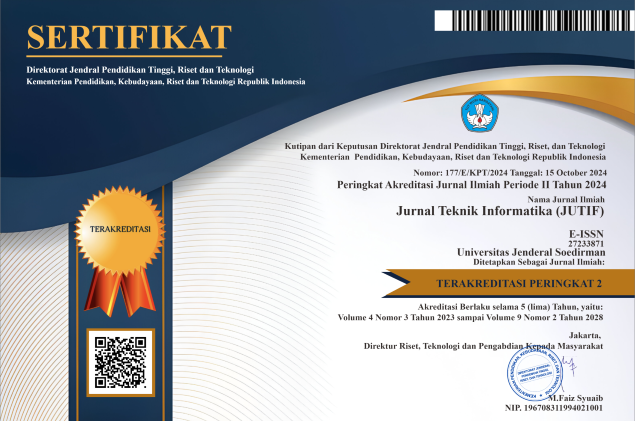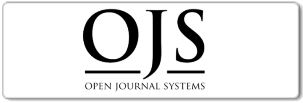ENHANCED SPEED AND ACCURACY IN COCOA FRUIT DISEASE IDENTIFICATION USING THE INCEPTION-RESNET CONVOLUTIONAL NEURAL NETWORK (CNN) ALGORITHM
DOI:
https://doi.org/10.52436/1.jutif.2025.6.1.4144Keywords:
cacao fruit, convolutional neural network, deep learning, digital image processing, inception, resnetAbstract
The increase in world cocoa consumption is not accompanied by an increase in production, causing a problem of supply shortages in the world. One of the causes of the stagnation in the increase in cocoa production is due to diseases that attack cocoa fruit. The disease can cause unproductive plants, unusable cocoa fruit, and even cause the spread of epidemics in a cocoa fruit garden. One of the preventions that can be done is to identify diseases in cocoa fruit in order to reduce the spread of the disease. The identification process is usually carried out independently by farmers. Identification of cocoa fruit diseases requires knowledge and experience by farmers, so it can cause misidentification or failure to identify the disease. In addition, other factors can arise such as the number of farmers who check, the area of the cocoa fruit garden, and the urgency of identification. To help overcome these problems, a Convolutional Neural Network (CNN) model was developed with the Inception and ResNet architectures. The data used were images obtained from Davao City, Philippines. The model obtained from the analyzed dataset got the best results of 0.99, a specificity value of 0.99, and an F1-score value of 0.99. The model configuration used is a learning rate value of 0.0001, RMSProp optimization function, initialization function (x) He uniform, initialization function (y) Glorot normal, and a batch size of 32.
Downloads
References
L. Armengot, L. Ferrari, J. Milz, F. Velásquez, P. Hohmann, dan M. Schneider, “Cacao agroforestry systems do not increase pest and disease incidence compared with monocultures under good cultural management practices,” Crop Prot., vol. 130, hal. 105047, 2020, doi: 10.1016/j.cropro.2019.105047.
L. Nesi Bria, “Penentuan Posisi Ekspor Kakao Indonesia Menurut Sembilan Negara Tujuan Di Pasar Internasional,” KAPITA J. Agribisnis Pembang. Pertan., vol. 1, no. 2, hal. 58–66, 2022, doi: 10.52562/kapita.v1i2.386.
J. P. Marelli et al., “Chocolate under threat from old and new cacao diseases,” Phytopathology, vol. 109, no. 8, hal. 1331–1343, 2019, doi: 10.1094/PHYTO-12-18-0477-RVW.
C. Rodriguez, O. Alfaro, P. Paredes, D. Esenarro, dan F. Hilario, “Machine Learning Techniques in the Detection of Cocoa (Theobroma cacao L.) Diseases,” Annalsofrscb.Ro, vol. 25, no. 3, hal. 7732–7741, 2021, [Daring]. Tersedia pada: http://annalsofrscb.ro/index.php/journal/article/view/2317
N. Maulidah, Indrabayu, dan I. S. Areni, “Water Sprouts Detection of Cacao Tree Using Mask Region-based Convolutional Neural Network,” 2020, vol. 4, no. 27, hal. 1–16. doi: 10.1109/ICT49546.2020.09239443.
S. Kumi, D. Kelly, J. Woodstuff, R. K. Lomotey, R. Orji, dan R. Deters, “Cocoa Companion: Deep Learning-Based Smartphone Application for Cocoa Disease Detection,” Procedia Comput. Sci., vol. 203, hal. 87–94, 2022, doi: 10.1016/j.procs.2022.07.013.
G. Latif, S. E. Abdelhamid, R. E. Mallouhy, J. Alghazo, dan Z. A. Kazimi, “Deep Learning Utilization in Agriculture: Detection of Rice Plant Diseases Using an Improved CNN Model,” Plants, vol. 11, no. 17, 2022, doi: 10.3390/plants11172230.
Y. Chen et al., “Classification of lungs infected COVID-19 images based on inception-ResNet,” Comput. Methods Programs Biomed., vol. 225, hal. 107053, 2022, doi: 10.1016/j.cmpb.2022.107053.
P. Sharma, Y. P. S. Berwal, dan W. Ghai, “Performance analysis of deep learning CNN models for disease detection in plants using image segmentation,” Inf. Process. Agric., vol. 7, no. 4, hal. 566–574, 2020, doi: 10.1016/j.inpa.2019.11.001.
L. Trihardianingsih, A. Sunyoto, dan T. Hidayat, “Classification of Tea Leaf Diseases Based on ResNet-50 and Inception V3,” Sinkron, vol. 8, no. 3, hal. 1564–1573, 2023, doi: 10.33395/sinkron.v8i3.12604.
R. Wightman, H. Touvron, dan H. Jégou, “ResNet strikes back: An improved training procedure in timm,” Comput. Res. Repos., vol. abs/2110.0, hal. 1–22, 2021, [Daring]. Tersedia pada: http://arxiv.org/abs/2110.00476
M. Ahmed dan A. Ahmed, “Palm tree disease detection and classification using residual network and transfer learning of inception ResNet,” PLoS One, vol. 18, no. 3 March, hal. 1–19, 2023, doi: 10.1371/journal.pone.0282250.
M. T. Ahad, Y. Li, B. Song, dan T. Bhuiyan, “Comparison of CNN-based deep learning architectures for rice diseases classification,” Artif. Intell. Agric., vol. 9, hal. 22–35, 2023, doi: 10.1016/j.aiia.2023.07.001.
V. Maeda-Gutiérrez et al., “Comparison of convolutional neural network architectures for classification of tomato plant diseases,” Appl. Sci., vol. 10, no. 4, 2020, doi: 10.3390/app10041245.
C. Song et al., “Maize seed appearance quality assessment based on improved Inception-ResNet,” Front. Plant Sci., vol. 14, no. August, hal. 1–13, 2023, doi: 10.3389/fpls.2023.1249989.
R. K. Shukla dan A. K. Tiwari, “Masked Face Recognition Using MobileNet V2 with Transfer Learning,” Comput. Syst. Sci. Eng., vol. 45, no. 1, hal. 293–309, 2023, doi: 10.32604/csse.2023.027986.
S. R. Shah et al., “Comparing Inception V3, VGG 16, VGG 19, CNN, and ResNet 50: A Case Study on Early Detection of a Rice Disease Syed,” Agronomy, vol. 13, no. 6, hal. 1–13, 2023, doi: https://doi.org/10.3390/agronomy13061633.
R. F. Mansour dan N. O. Aljehane, “An optimal segmentation with deep learning based inception network model for intracranial hemorrhage diagnosis,” Neural Comput. Appl., vol. 33, no. 20, hal. 13831–13843, 2021, doi: 10.1007/s00521-021-06020-8.
C. Szegedy et al., “Going deeper with convolutions,” in Proceedings of the IEEE Computer Society Conference on Computer Vision and Pattern Recognition, 2015, vol. June, hal. 1–9. doi: 10.1109/CVPR.2015.7298594.
K. He, X. Zhang, S. Ren, dan J. Sun, “Deep residual learning for image recognition,” in Proceedings of the IEEE Computer Society Conference on Computer Vision and Pattern Recognition, 2016, vol. 2016-Decem, hal. 770–778. doi: 10.1109/CVPR.2016.90.
Z. Sheng, H. Wang, G. Chen, B. Zhou, dan J. Sun, “Convolutional residual network to short-term load forecasting,” Appl. Intell., vol. 51, no. 4, hal. 2485–2499, 2021, doi: 10.1007/s10489-020-01932-9.
R. C. Gonzalez dan R. E. Woods, 4TH EDITION Digital image processing, 4 ed. New York: Pearson, 2018.
H. S. Obaid, S. A. Dheyab, dan S. S. Sabry, “The Impact of Data Pre-Processing Techniques and Dimensionality Reduction on the Accuracy of Machine Learning,” IEEE Access, hal. 279–283, 2019, doi: 10.1109/IEMECONX.2019.8877011.
J. Liang, Y. Liu, dan V. Vlassov, “The Impact of Background Removal on Performance of Neural Networks for Fashion Image Classification and Segmentation,” in Proceedings - 2023 Congress in Computer Science, Computer Engineering, and Applied Computing, CSCE 2023, 2023, hal. 1960–1968. doi: 10.1109/CSCE60160.2023.00323.
L. M. Pereira, A. Salazar, dan L. Vergara, “A Comparative Analysis of Early and Late Fusion for the Multimodal Two-Class Problem,” IEEE Access, vol. 11, hal. 84283–84300, 2023, doi: 10.1109/ACCESS.2023.3296098.
S. Papadopoulos, G. Koukiou, dan V. Anastassopoulos, “Decision Fusion at Pixel Level of Multi-Band Data for Land Cover Classification—A Review,” J. Imaging, vol. 10, no. 1, 2024, doi: 10.3390/jimaging10010015.
O. Chandraumakantham, N. Gowtham, M. Zakariah, dan A. Almazyad, “Multimodal Emotion Recognition Using Feature Fusion: An LLM-Based Approach,” IEEE Access, vol. 12, hal. 108052–108071, 2024, doi: 10.1109/ACCESS.2024.3425953.
T. Jiao, C. Guo, X. Feng, Y. Chen, dan J. Song, “A Comprehensive Survey on Deep Learning Multi-Modal Fusion: Methods, Technologies and Applications,” Comput. Mater. Contin., vol. 80, no. 1, hal. 1–35, 2024, doi: 10.32604/cmc.2024.053204.
M. A. Ganaie, M. Hu, A. K. Malik, M. Tanveer, dan P. N. Suganthan, “Ensemble deep learning: A review,” Eng. Appl. Artif. Intell., vol. 115, no. August, hal. 1–45, 2022, doi: 10.1016/j.engappai.2022.105151.
Y. S. Taspinar, I. Cinar, dan M. Koklu, “Classification by a stacking model using CNN features for COVID-19 infection diagnosis,” J. Xray. Sci. Technol., vol. 30, no. 1, hal. 73–88, 2022, doi: 10.3233/XST-211031.
G. Zeng, “On the confusion matrix in credit scoring and its analytical properties,” Commun. Stat. - Theory Methods, vol. 49, no. 9, hal. 2080–2093, 2020, doi: 10.1080/03610926.2019.1568485.
D. Guest dan P. Keane, “Vascular-streak dieback: A new encounter disease of cacao in Papua New Guinea and Southeast Asia caused by the obligate basidiomycete Oncobasidium theobromae,” Phytopathology, vol. 97, no. 12, hal. 1654–1657, 2007, doi: 10.1094/PHYTO-97-12-1654.
C. Szegedy, V. Vanhoucke, S. Ioffe, J. Shlens, dan Z. Wojna, “Rethinking the Inception Architecture for Computer Vision,” in Proceedings of the IEEE Computer Society Conference on Computer Vision and Pattern Recognition, 2016, vol. December, hal. 2818–2826. doi: 10.1109/CVPR.2016.308.
P. Bansal, R. Krueger, M. Bierlaire, R. A. Daziano, dan T. H. Rashidi, “Bayesian estimation of mixed multinomial logit models: Advances and simulation-based evaluations,” Transp. Res. Part B Methodol., vol. 131, no. December, hal. 124–142, 2020, doi: 10.1016/j.trb.2019.12.001.
A. F. M. Harvyanti, R. I. Baihaki, Dafik, Z. R. Ridlo, dan I. H. Agustin, Application of Convolutional Neural Network for Identifying Cocoa Leaf Disease, vol. 2. Atlantis Press International BV, 2023. doi: 10.2991/978-94-6463-174-6_21.
K. J. Ayikpa, D. Mamadou, P. Gouton, dan K. J. Adou, “Classification of Cocoa Pod Maturity Using Similarity Tools on an Image Database: Comparison of Feature Extractors and Color Spaces,” Data, vol. 8, no. 6, 2023, doi: 10.3390/data8060099.


























